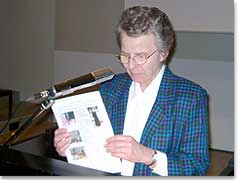 |
| Sister Thomasine
Treese with the printouts of the report on schoenstatt.de, about the
closing of the process for Sr.Emilie on diocesan level Schwester Thomasine Treese mit dem Ausdruck des Berichts auf schoenstatt.de über den Abschluss des Seligsprechungsprozesses für Schw. Emilie auf Diözesanebene |
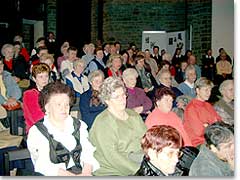 |
| Approximately
200 participants in the Father Kentenich House, among them Schoenstatt
Mothers from Fulda and a group of pilgrims from Aulendorf. Ungefähr 200 Personen kamen ins Pater Kentenich-Haus, darunter Schönstattmütter aus Fulda und Pilger aus Aulendorf |
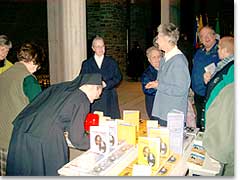 |
| Videos, books
and brochures on Sr. Emilie were displayed in the hall. Videos, Bücher und Hefte über Sr. Emilie waren in der Eingangshalle aufgebaut. |
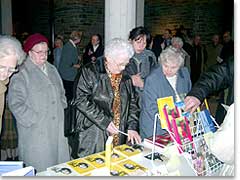 |
| The recently
published brochures and books were bestsellers Die neuen Bücher und Broschüren waren sehr begehrt |
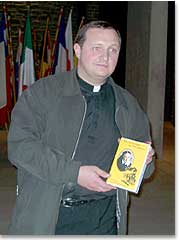 |
| Father Wachter
came with the pilgrims from Aulendorf Pfarrer Wachter begleitete die Pilger aus Aulendorf |
| Fotos: POS, Fischer © 2002 |
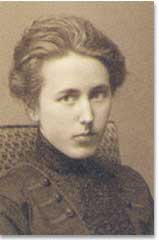 |
| Emilie Engel |
| Fotos: Schönstätter Marienschwestern, Archiv© 2002 |
SCHOENSTATT, mkf. The spiritual sons and daughters of Father Kentenich, modeled by him and matured to an outstanding Christian life, are to be witnesses of their spiritual father. The lives of persons who in an model way have lived to the ideals of Schoenstatt's spirituality tell the story of Schoenstatt, and tell the story of the one whom they owe the guidance to this ideal and the tools to achieve the goal: next to God and the Blessed Mother, the founder of Schoenstatt. The jewels in Schoenstatt's collection are to highlight the master jewel. One of these "jewels", Sr. Emilie Engel, was in the center of a presentation in the Father Kentenich House on behalf of the closing of her process of beatification on diocesan level.
With Sr. Emilie and this applies also to those Schoenstatters already beatified or with their processes in progress the founder and his charisma begins to "shine", gets his concept of a new community of free, firm and apostolic persons a face, a history,
What Sr. Emilie says about Father Kentenich, what he means to her and her life, one of the persons in charge in the tribunal in Trier said, would be an impressive testimony for him. Her life would be a mirror of the Founder, as she would be an epitome of the "new man in the new community" that Father Kentenich intended to mould, to educate. Without Sister Emilie, Father Kentenich would be difficult to understand as the counterpart would be missing. This was one of the remarks of Sr. Thomasine Treese, postulator of the cause of beatification for Sr Emilie, that left the 200 or so participants in the Father Kentenich House astounded.
Before, the presentation already offered in Trier on February 26 had introduced into the life of Sr. Emilie and her mission.
Some Statistics on the Process
In continuation, Sr. Thomasine gave a quick tour of process statistics in view of the three phases of the process: testimonies, writings, non-cult. She spoke of the number of witnesses interrogated, the amount of testimonies from chronicles, letters, condolence cards, 380 pages of statements given by the Founder; 2,500 letters from Sr Emilie and over 250 short greetings on cards, that, together with her other writing, had been translated into English which is the official language of the process. Finally, the tomb in Metternich had been visited and it was cleared that no unauthorized cult in public rooms took place. With the closing of the process, 20,000 pages, packed and sealed in 23 boxes, were to be taken to Rome for the next phase. In the second phase, the acts from the diocesan process will be studied and evaluated, a "positio" (study) on the life and virtues of Sr. Emilie has to be put together, and finally, God has to put his seal on all the efforts by working a miracle on the intercession of Sr Emilie.
After the presentation, the participants used the opportunity to look at the newly published brochures, videos and booklets on Sr. Emilie that were displayed in the entrance hall.
Their Lives Tell Schoenstatt's Story
Sister Emilie became who she was through Schoenstatt, said Sr. Thomasine. Through her process, worked on in the diocese where also the process for Father Kentenich is carried out, the founder has been seen in a brighter light, as Auxiliary Bishop Leo Schwarz remarked on behalf of a meeting with members of the General Presidium of Schoenstatt in December 2000.
The lives of Karl Leisner, the first Schoenstatt member beatified, and the six Schoenstatt members "on the way to beatification" Sr. Emilie, João Pozzobon, Mario Hiriart, Gertraud von Bullion, Joseph Engling, Franz Reinisch - , and of many other "jewels of Schoenstatt" whose life have made a difference to Schoenstatt branches, countries, groups, tell the story of the Covenant of Love that is able to transform a person totally, however also tell the story of individual persons who with their mission, background, mentality strengths and weaknesses have marked the destiny of Schoenstatt.
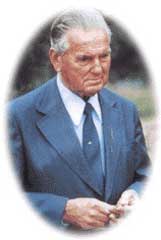 |
| Don Joγo Pozzobon |
| Fotos: Archiv © 2002 |
Don João Pozzobon (1904 1985), Brazil:
Bringing the MTA to the ends of the world - The Schoenstatt Rosary Campaign
John Louis Pozzobon, a member of the Schoenstatt Apostolic Movement in Brazil, father of seven children, in 1950 was asked by a Sister of Mary to take a picture of the Mother Thrice Admirable of Schoenstatt to families so that they could pray the rosary together. John Pozzobon assumed this task and for the following 35 years until his death made it his personal mission. He walked more than 87,000 miles with this image, taking the Blessed Mother to homes, hospitals, schools, and jails, inciting in all these places the attachment to her, and the prayer of the rosary. This "Campaign" as John Pozzobon liked to call it had a humble beginning, like each work of God; since 1984, it spread across South America to Central America and North America as well as to countries in Europe, Asia, and Africa, altogether 85. John lived his life to the unconditional YES of Mary. He lived a simple and humble life, dedicated completely to his family, to Schoenstatt and the Marian mission; the social commitment of the Campaign was essential to him. In faithfulness to Father Kentenich, whose "small student" he loved to call himself, he continued his mission also in times of being questioned and misinterpreted. Thanks to his faithfulness, hundreds thousands of families throughout the world receive the Pilgrim Mother, are united in prayer, discover Jesus in a deeper way, and are blessed by the graces of the Schoenstatt Shrine.
On the morning of June 27, 1985, deacon John Louis Pozzobon was run over by a truck, in midst of a thick fog, while heading towards the Shrine of Our Lady of Schoenstatt to attend to Mass, as he did each day, a few days after he had offered his life that the Campaign would become international.
More: www.pozzobon.org
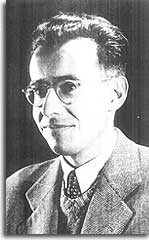 |
| Mario Hiriart |
| Fotos: Archiv © 2002 |
Mario Hiriart (1931 1964), Chile
Where Heaven Meets Earth Distinctive Lay Spirituality
As a student, Mario Hiriart got to know Schoenstatt; gradually, Schoenstatt's spirituality began to radically transform his life and nature. As an engineer and later as university professor, he felt called to live a radical Christian life and to unite work, faith, apostolic commitment, leisure, and prayer in an organic way. As promoter of an distinctive lay spirituality that is typical for Schoenstatt, he decided to join the Institute of the Brothers of Mary: he wanted to commit all his time, energy, and talents to make God present and able to be experienced in the contemporary world marked by the rhythm and laws of industry, research, and technical enhancement. In his lessons, in his apostolate among youth, and in his personal reflections he worked on an deeper understanding of and convincing response to the challenges imposed on Christian lay persons in a growingly secularized world. At the same time he grew into a deep personal relationship with the Jesus to whom he offered his life as a living chalice, like Mary. At age 33, he accepted his terminal illness of cancer as a final possibility to give all for heaven and earth.
More: www.schoenstatt.net/mario-hiriart or: www.mariohiriart.cl.
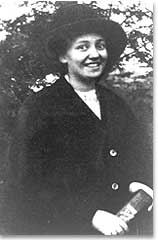 |
| Gertraud von Bullion |
| Foto: Archiv © 2002 |
Gertraud von Bullion (1891 - 1930), Germany
Women's Mission for Schoenstatt and the World "I want to serve"
When Gertraud von Bullion in 1917 got to know Schoenstatt while working as a volunteer nurse in the military hospital in Mons, Schoenstatt was only for men. She was excited with the ideas, and the testimonies of genuine committed life that she heard from soldiers who belonged to Schoenstatt. She began a correspondence with Father Kentenich and kept contact, and became the first female member of the Schoenstatt Movement. On December 8, 1920, she she dedicated herself to the Mother Thrice Admirable of Schoenstatt, together with her cousin; this dedication is the root of the Women's Federation and of the entire Women's movement in Schoenstatt. Gertraud worked hard and with genuine apostolic commitment for the development of the women's federation and league, until a severe tuberculosis step by step forced her to give up her outward activities and concentrate on the faithful accepting of her sickness and all the renouncements connected with it. Lead by her life's ideal "I want to serve" she found her way to turn her sickness into a possibility of serving others, and serving the Schoenstatt movement by giving all at the disposal of Jesus and Mary.
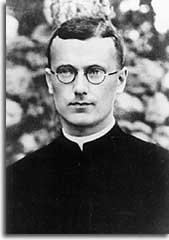 |
| Franz Reinisch |
| Foto: Archiv © 2002 |
Father Franz Reinisch (1903 - 1942), Austria
Decision on a Matter of Conscience
Father Franz Reinisch is the only Catholic priest who was executed during the "Third Reich". As a decision on a matter of conscience he, after being recruited to the army, refused the oath of allegiance to Hitler. He was imprisoned, sentenced to death and beheaded on August 21, 1942. Father Reinisch, a Pallottine Father, born in Austria, has his first personal Schoenstatt experience on the day when the remains of the hero sodalists, the first Schoenstatt members who lost their lives on World War I were brought back from France to Schoenstatt, in 1934. He worked actively in the Schoenstatt Movement, specially with the Men's branches. His decision to refuse the oath of allegiance brought him into the dilemma of all Christian radicalism his decision meant to lose his life and he knew it; it would cause pain to parents, family, community. It also endangered Schoenstatt and his own Pallottine community a motive for his superiors to not back up his decision -,and cast a shadow on each other priest and Christian who had given the oath. Yet Reinisch felt called to follow his special vocation and set an example of following conscience and the Personal Ideal in a matter of life and death.
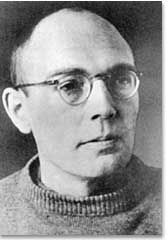 |
| Karl Leisner |
| Foto: Archiv © 2002 |
Karl Leisner (1915- 1945), Germany
Christ, my Passion Ordained in Dachau
Karl Leisner was beatified by Pope John Paul II in 1996 in Berlin. For Karl Leisner, who as a student for the priesthood joined a Schoenstatt Federation group one member of this group being the later Bishop of Münster, Heinrich Tenhumberg , the "moments spent in the Blessed Mother's Shrine of Grace", the Original Shrine in Schoenstatt, were decisive hours of grace on turning points of this life. Christ my passion: led by this ideal, he worked as a committed youth leader, and fought his way towards the decision for the priesthood. A remark on the failed assassination attempt on Hitler, uttered during a recovery stay in a sanatorium, brought the recently ordained deacon first to jail and then to the concentration camp. The almost healed tuberculosis broke out again in Dachau. Although his health rapidly deteriorated, his contagious joy he asked to send his guitar to Dachau remained unbroken. When a French Bishop was confined to the concentration camp, Karl Leisner's dream came true. On December 17, 1944, he was ordained priest in Dachau, and celebrated his first and only Holy Mass on December 26, 1944. He died soon after he was freed from the concentration camp in a sanatorium in Planegg.
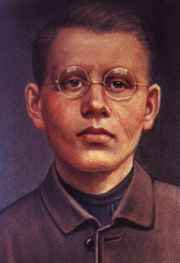 |
| Joseph Engling |
| Foto: Archiv © 2002 |
Joseph Engling (1898 1918), Germany
The Founding Document Lived
He is the "founding document lived", according to Father Kentenich who already in the year after Joseph Engling's death, in 1919, began to publish his letters and the notes from his diary in the Schoenstatt magazine "MTA". Joseph Engling, member of the founder generation of Schoenstatt, from a remote village in Eastern Prussia (then Germany, now Poland), was a student at the Pallottine's School in Schoenstatt. He was not present on the 18th of October 1914, when Schoenstatt was founded through the Covenant of Love of Father Kentenich, and a group of students, with the Blessed Mother in the chapel that now is known as "Original Shrine". But he opened his heart without reserve and made Schoenstatt his life; his diary notes and letters are a pure and profound reflection of the impulses given by Father Kentenich. Joseph offered his physical limitations, successes and vast experiences of unsuccessful apostolic commitment, his self-education, and the hardships of his life as a soldier on the battlefields of World War I for the growth and spread of Schoenstatt. On May 31, 1918, he offered his life for this intention. He died on October 4, 1918, near Cambrai, France.
Mirrored here may our life tell your story
A well-known song by Graham Kendrick - Shine, Jesus, Shine - ends with the verse: As we gaze on your kingly brightness so our faces display your likeness ever changing from glory to glory mirrored here may our life tell your story... The faces of these and many other persons who made Schoenstatt their life display the likeness of Jesus, and display in the same way the likeness to Mary, and to the Founder - in a multifaceted, original and unique way. Each life tells the story of the covenant of love in an authentic and always different way, tells the story of what the experience of being loved and being called to love and change the world can work: "Lord, and let there be light!"